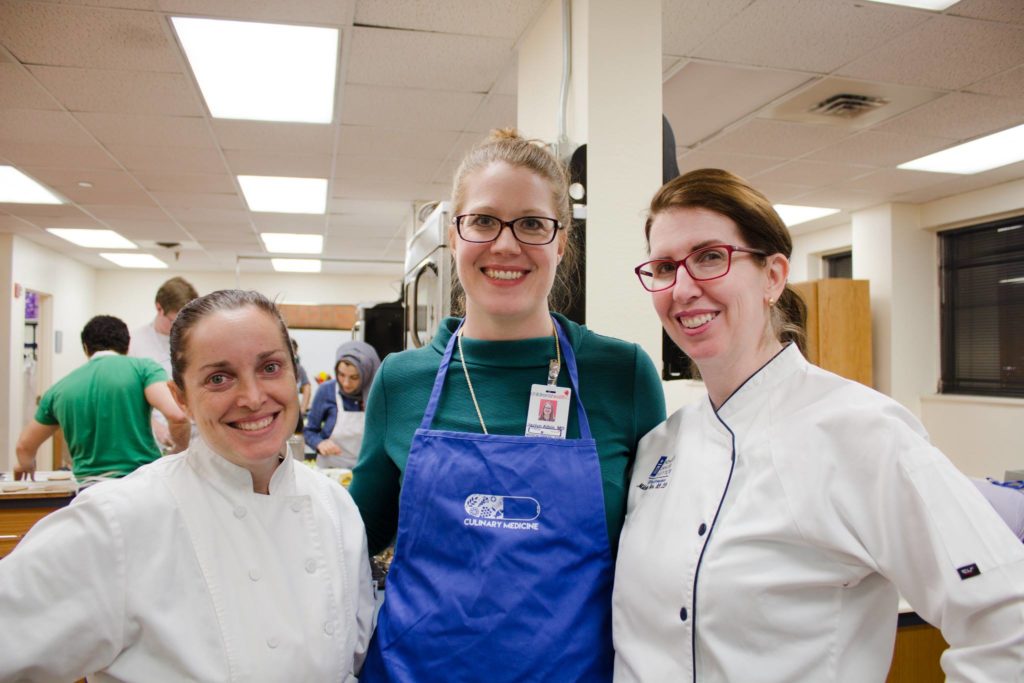In spite of the preventable nature of this public health crisis and clear research revealing the link between diet and health, physicians receive inadequate nutrition education to equip them for addressing their patients’ needs. Most medical schools in the US fail to meet national recommendations for nutrition education.3 An emerging solution to enhance practical knowledge of food science and the research behind health and food is now rapidly growing and is known as Culinary Medicine.
So, What Happens in a Culinary Medicine Class?
Innovative solutions are vital to reverse the lifestyle-related disease burden and unsustainable healthcare costs in the United States, and Culinary Medicine uniquely brings a practical, inter-professional approach with great potential for turning the tide toward better health. During a Culinary Medicine course, participants work in small teams to prepare delicious, affordable food in a hands-on cooking class. Guided by physician and dietitian coaches, the sessions include a brief didactic reviewing the practical food science relevant to the theme of the class. For health professional learners, each session also includes case-based discussions that promote thoughtful dialogue about dietary interventions for a variety of medical problems. Additionally, learners engage with the nutrition literature, allowing their new knowledge of the impact of food on health to serve as a tool in their arsenal to combat chronic diseases. Each session is collaborative, engaging, practical, and inspiring of personal change for better health.
Why disseminate this to the public? Because, for example, improvements in diabetes control, blood pressure, and cholesterol have been demonstrated in patients with diabetes who participated in community culinary curriculum.

Chef Tara Anderson, Jaclyn Albin, M.D., Milette Siler RD, LD
Culinary Medicine is an evidence-based field connecting food and medicine to empower informed decisions. Research demonstrates superior effectiveness of hands-on cooking compared to traditional methods of teaching nutrition, improving medical students’ patient counseling skills.4 Medical school-based nutrition education in teaching kitchens can equip health professional students, in-training physicians, and practicing health professionals with appropriate tools to improve personal nutrition and well-being, to counsel their patients, and to share the model of Culinary Medicine in the community.
Proven Impact
Why disseminate this to the public? Because, for example, improvements in diabetes control, blood pressure, and cholesterol have been demonstrated in patients with diabetes who participated in community culinary curriculum.5
As we move forward in the fight for wellness, we must have a fresh outlook driving the investigation of new and creative solutions. We must optimize our traditional strategies with renewed collaboration, connection to community partners, and visions for innovation. The potential for Culinary Medicine to change the way we think about food and to then transform our health rests on the back of high-quality research to study this method in education, patient care, and community settings.
The Culinary Medicine program aims to assure that every student who takes the class – every future healer – has the right tools in their arsenal to open a new dialogue with patients about food and wellness.
Thus, the kitchen is a new kind of lab where I hope many find the same potential, passion, and wellness that encourages my team in the drive to bettering health outcomes for our patients and our community.
Just as a chef without the right knife will struggle to make the perfect slice, a physician without the right knowledge will struggle to advise their patients on how they can use food to prevent disease. The Culinary Medicine program aims to assure that every student who takes the class – every future healer – has the right tools in their arsenal to open a new dialogue with patients about food and wellness.
Hungry for more?
Follow Dr. Albin on Instagram
Check out the Culinary Medicine at UT Southwestern Facebook page
Read about our community’s history of seeking answers about nutrition
Sources
1. Collaborators, U.S.B.o.D., et al., The State of US Health, 1990-2016: Burden of Diseases, Injuries, and Risk Factors Among US States. JAMA, 2018. 319(14): p. 1444-1472.
2. Eisenberg, D.M. and J.D. Burgess, Nutrition Education in an Era of Global Obesity and Diabetes: Thinking Outside the Box. Academic medicine : journal of the Association of American Medical Colleges, 2015. 90(7): p. 854-60.
3. Adams, K.M., The State of Nutrition Education at US Medical Schools. Journal of Biomedical Education, 2015.
4. Monlezun, D.J., et al., Novel Longitudinal and Propensity Score Matched Analysis of Hands-On Cooking and Nutrition Education versus Traditional Clinical Education among 627 Medical Students. Advances in preventive medicine, 2015. 2015: p. 656780.
5. Monlezun, D.J., et al., Medical school-based teaching kitchen improves HbA1c, blood pressure, and cholesterol for patients with type 2 diabetes: Results from a novel randomized controlled trial. Diabetes research and clinical practice, 2015. 109(2): p. 420-6.